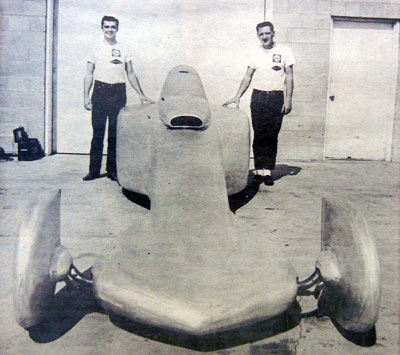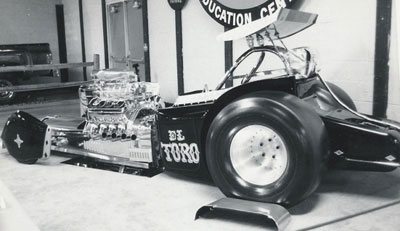

Continuing the Breed-lovefest
 |
|
 |
|
 |
(Above) Craig Breedlove, left, and engine builder Dave Carpenter with the new and still unpainted Spirit II outside of Quinn Epperly's shop (Left) Breedlove held a model of Spirit of America I, which had wheel fairings on the rear tires when it set the land-speed record in 1963 and inspired the front fairings on the Spirit II dragster. |
There have been a couple of interesting developments in the last few days in regards to our ongoing discussion of wheel pants and Craig Breedlove’s streamlined slingshot Spirit II dragster.
Bob Frey clued me in to a nice two-page story on the Breedlove car that ran in the March 6, 1964, issue of National DRAGSTER and further explained the thinking behind the design.
The detailed article, written by then-DRAGSTER Editor Dean Brown and accompanied by photographs from Associate Editor Dan Roulston, was packed with technical details about the design and its “wetted” areas – “all of the skin area that touches the airflow over, around, and under the car,” according to Breedlove. “Consider the air as molasses, and it’s easy to see that as it rubs against the body surface, it creates drag and slows the car. Less surface, or ‘wetted,’ area results in less drag and more speed. It’s probably more important than the frontal area to the success of the car.”
One might think that covering the engine and the front and rear tires would add surface “wetted” area. But Breedlove explained that the total surface area of all of those elements – including things like the magnetos and rear brake -- was, in fact, larger than the surface area of the body. Beforehand, Breedlove, with aerospace worker Bernie Pershing, had charted all NHRA record holders, noting two factors -- aerodynamic drag to vehicle weight and tire thrust to vehicle weight ratio -- that he considered most important to dragster design, then plotted those against his design for Spirit II and found the results quite promising.
You’ll also note that Spirit II had no air-disturbing external drag link steering or radius rods as was common for slingshots of the day but instead used a straight shaft connected to a Fiat steering box welded to the front axle.
Because the subject of the day (month?) is wheel pants, I won’t go into a lot more detail about the dragster's full design, but when the article was written (before the car had actually been down the strip), Breedlove and body builder Quinn Epperly estimated that the front fairings alone would cut air drag by 30 percent and were good for about 10 mph not because of their clean lines but because they would eliminate the turbulence that the uncovered front tires would kick up and tumble onto the rest of the car. As noted previously, this benefit largely went unnoticed (or at least was not mentioned in any of my readings) until Don Garlits rediscovered the fact in 1985, which led to his covering the front tires on his semi-streamlined Swamp Rat XXX.
Last Tuesday, we speculated that the front fairings on Breedlove's Spirit II were inspired by Frank Lockhart's late-1920s LSR car -- which I just discovered was re-created last year; story here -- but we missed an intermediate step as the story reports that they instead were modeled after the fairings that covered the rear wheels of the Spirit of America I LSR car pictured above (which may have been inspired by Lockhart).
 |
Dennis Friend passed along the Kaye Trapp photos at right, taken from one of the weekly drag rags (he can’t remember which), that show a car remarkably similar to the Breedlove machine but with a caption that purports it to be a twin-engine fuel dragster conceived by Nye Frank, Epperly’s longtime tin-bending pal and onetime Breedlove crew chief.
Friend huddled with George Klass, one of the major players in the Breedlove (and other) camps of the era and deduced that these photos are actually of a 1/4-scale model of the Breedlove car constructed for wind-tunnel purposes.
“I am 99 percent certain that the wind-tunnel model and Craig's dragster are for the same car,” said Klass. “I think all the confusion is due to Nye's name being used with the wind-tunnel model. Remember, Nye was the crew chief for Breedlove. Since Craig's dragster was built first, it's also possible that Nye based his own streamliner body on the data they got off this model. I believe that Nye did have quite a bit of input into the design; however, the twin Chevy car came out after Craig's car. The twice-motored dragster body was fiberglass, and Craig's car body was aluminum. They were similar but in no way the same. Craig's car was never designed or intended to be a two-engine car. The biggest issue was it had to use Goodyear drag slicks, the very first drag tires they ever made, and they were TERRIBLE, like racing on grease.”
I don’t know if Frank had planned a twin-engine twin to Breedlove’s car or if the caption writer had it wrong. More of history’s mysteries …

Back to wheel pants …
 |

Eagle-eyed David Hapgood spied this advertisement for wheel pants in the May 16, 1975, issue of National DRAGSTER.
|
Following up on the wheel-pants-wearing El Toro fuel altered, its current owner, John Hoyt, sent the photo at right showing the car so equipped at the 1977 Toledo Auto Show. It’s a cool look, but I’m still waiting to see if the car was ever run in this configuration.
By the way, Hoyt is in the process of restoring the car, which he found last year in lower northern Michigan, “still in wonderful condition, with all original parts and aluminum panels still attached, except the winglet style that I am still looking for. I have been able to contact five of the drivers of El Toro but no luck so far. If I can’t find the original, I will have Al Bergler build us another one. My real problem is finding an old '70s iron Hemi for the rebuild. I now have a 546 Chevy injected alky engine it; that’s OK, but that's like kissing your sister: It’s a kiss with no meaning; the only thing that counts is a blown fuel Hemi! The goal, a six-second pass at 200-plus mph.”
By the way, I mentioned Tuesday that an online article cited El Toro as one of only two true competition vehicles to win the prestigious Ridler Award from the Detroit Autorama.
I found a list of Ridler winners online and discovered that that’s not true. Bergler’s sleek, canopied More Aggravation AA/Coupe won the first award (1964), and Maynard Rupp’s rear-engine Chevoom “Funny Car” won it in 1966. Bob Sweatt’s El Toro won it in 1976, and then I see Dale Hunt’s Pontiac Grand Am Pro Stocker as the 1986 winner. Could be that Hunt’s car never actually ran on a track, but we know that Aggravation and Chevoom did. I found an interview online with Bergler, who called the Ridler Award the most important accolade of his career and one for which he is still widely known. Bergler, a member of the Michigan Motorsports Hall of Fame, has attended the Motorama since the 1950s. [Late update, 4/6/12: According to Bret Kepner, Hunt's Grand Am was actually a Super Gasser which, because of ISCA rules, competed in the Pro Stock class at the show. Kepner also noted another competition car that won the Ridler in 1995 Ridler, Bob Rizzoli's RCD-built '92 Mercedes-Benz 560 SEC C/Altered; "arguably the most deserving drag car to ever win the trophy," he opined.]
By the way, the Ridler Award is named in honor of Don Ridler, who was hired by the Michigan Hot Rod Association in 1957 as a promotions agent and publicist for the show. He booked popular bands like Duane Eddy and The Big Bopper to boost attendance at the show. He died in 1963, and the Ridler Award was established in his honor the next year.

 |
Tom Nagy sent this shot by his good friend Jerry Bennett at U.S. 131 Dragway from the 1975 Popular Hot Rodding Championships that confirms my suspicions that the 1975 Tommy Hendricks car was the 1973 Tommy Ivo Top Fueler. “Those wing struts look unmistakable to me,” he agreed.
 |
More English wheel pants: Johnny Cola sent this photo of an injected dragster called the Turbo Saxon (which does not appear to be turbocharged) and mused whether the English called the aerodynamic aids "wheel trousers."
 |
And then there's this late-1970s/early-1980s gem from Steve Reyes, showing that wheel pants aren't just for the asphalt: the Swain Bros. sand dragster on the course near the old Ontario Motor Speedway.

 |
The 1977 Rulebook cover showing Chase Knight’s Golden Gator Alcohol Dragster wearing wheel pants in the very publication that outlawed them brought Mike Hedworth to suggest that the real focus of that photo was his opponent in that third U.S. Nationals round, Ken Veney, and that “They probably thought people would use common sense that this was a picture from '76 when the pants were legal and not an example of what configurations were legal.” I don't know that I buy either argument; Veney was neither the 1976 Indy champ (Dave Settles) nor world champ (Brent Bramley), and although it's understood that the images are from the previous year (the Rulebook is typically available in the winter), my guess is this was an oversight and not something that would happen today, for sure.
Knight also had an interesting comment about that notorious photo: “Although it looks as if I’ve put a decent holeshot on Ken Veney, I had indeed red-lighted. I was always perturbed about that as I knew that I saw the yellow (there were no reaction timers in those days) and hadn’t even bothered to look at the Tree as I went by. It wasn’t until many years later that my old classmate (and Insider contributor) Jim Hill sent me a picture of that run from his perspective. You can see Jim in that photo, at the right guardrail, in the blue shirt and straw hat. He caught the moment of launch, and the heavy old Gator (nearly 2,350 pounds) had picked the wheels up out of the beams. It didn’t have a tendency to do that, but that image did ease my mind a bit regarding that mystery. That was the third round, in a 32-car field. We were running 6.70s and had gotten by Dave Beatty in the first round and Dale Hall in the second.”

And finally … Want to own a famous wheel-pants dragster? Frey also alerted me that Ivo’s restored 1974 wheel-pants dragster – the one that flipped in the lights at the 1974 Winternationals – will be on sale at the Mecum auction May 15-20 in Indianapolis, where Don Prudhomme’s 250-mph-barrier-breaking Pepsi Challenger Funny Car (Lot S182) will be sold. The Ivo car (Lot S200), which was mostly destroyed in that top-end tumble but rebuilt and campaigned later that year, was purchased by Funny Car hero Bruce Larson in 2001 and restored in 2007. Scrolling through the amazing list of cars that will go on the block, I also spied Breedlove’s famous 1968 Javelin (Lot F333), which covered the flying mile at Bonneville at 161 mph in 1968, setting a C/Production world record that stood for years.
Get those checkbooks out ...



















































